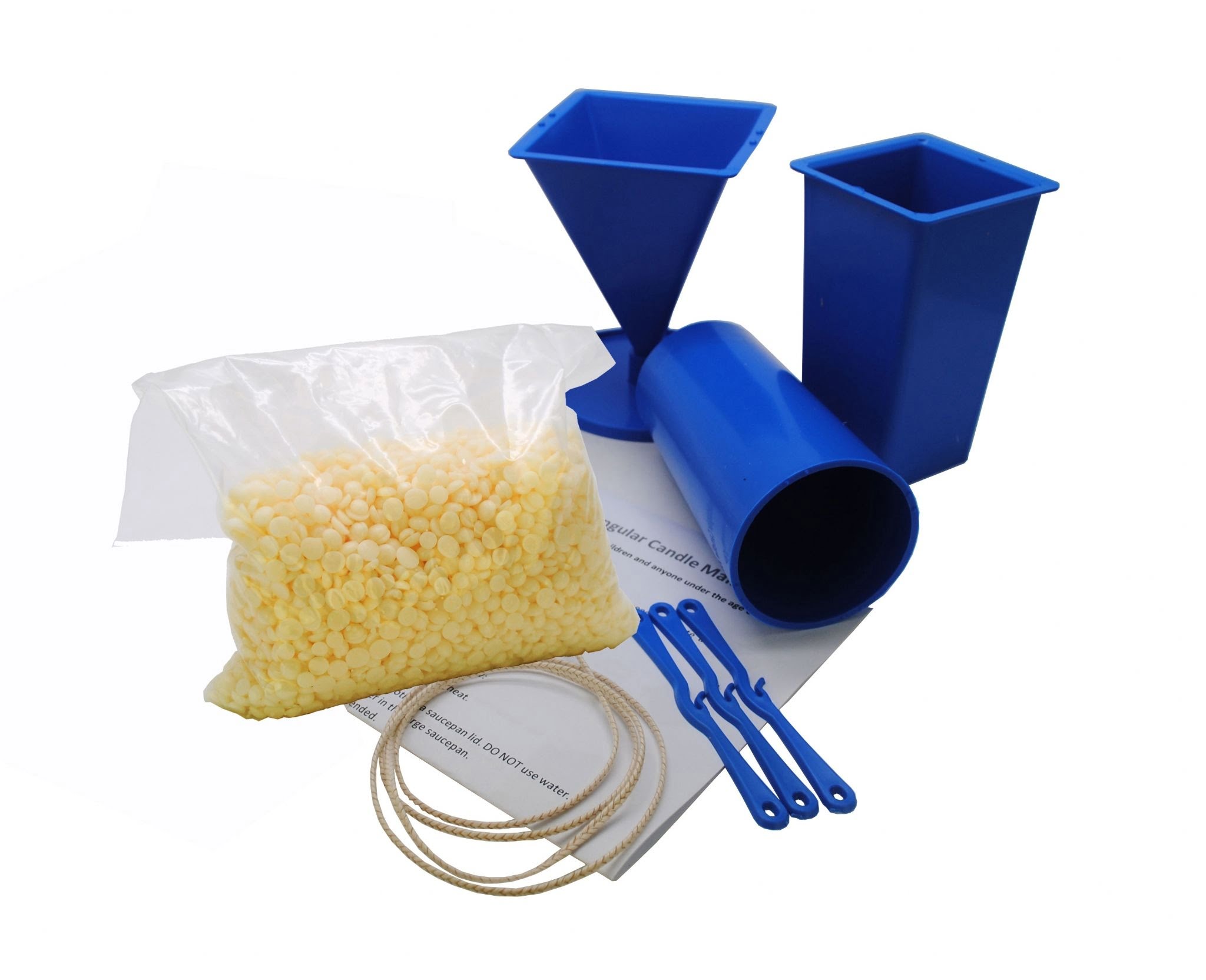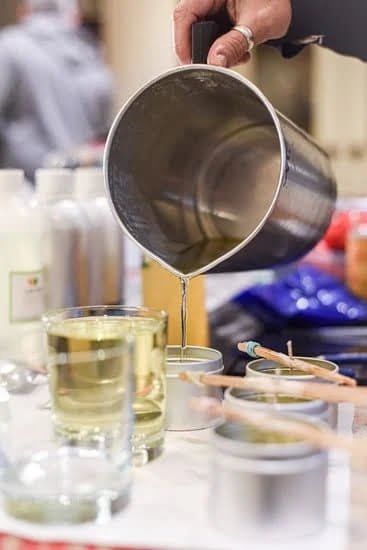Introduction
Candle making has been around for thousands of years. From the ancient Egyptians to modern-day American artisans, candle makers have used different materials and methods to craft beautiful, fragrant candles for any occasion. Soy wax has become a popular choice for today’s candle makers as it is cruelty-free and long lasting. This guide will provide step-by-step instructions on how to make soy candles from scratch using an array of supplies found at your local stores or online.
Before starting the project, you’ll need to decide what size candle you will be making and gather all the supplies necessary. Supplies needed include soy wax, a wick, fragrance oils, dye beads (optional), thermometer, double boiler (or equivalent), glass measuring cup with handle, and container(s) of desired shape/size. Assemble everything in a clean workspace before proceeding with the instructions.
When making soy candles, be sure to practice in a safe working environment that is free from distractions and flammable objects – kids and pets should be kept out of the area during this process as well. Wearing safety gear such as safety glasses is strongly suggested when working with heat sources and flammable waxes. Additionally, make sure the place you are using is well ventilated as dangerous fumes can result from candle making processes that involve high temperatures or hazardous chemicals like fragrance oils.
Soy candles are becoming increasingly popular because of their beauty, longevity compared to paraffin candles, sustainable ingredients and cost effectiveness compared other types of waxes available on the market today. The melt point for soy wax also allows for a wider range of fragrances than other waxes without compromising performance or quality burn time as long as directions are followed closely when pouring the melted wax into its container. Depending on your preferences you can use essential oil-based fragrances versus synthetic scent components like phthalates – if you choose to stick with essential oil fragrances make sure they are third party tested & certified therapeutic grade based due potential toxicity when present in large concentrations while burning or just sitting around exposed to oxygen over time alongside other considerations like room temperature fluctuations & possible exposure with human skin contact which could cause allergies given certain sensitivities; lastly more subtle dyes can also be added at this point by incorporating beeswax / paraffin beads if desired before moving onto the actual pouring sequence of operations explained hereafter…..
Benefits of Making Soy Candles
Making soy candles at home is a great way to save money and create custom décor pieces in your home. The benefits of making soy candles yourself rather than purchasing them store-bought can be numerous. Firstly, soy candles are made with vegetable oil and contain no toxins, making them healthier to burn indoors then their paraffin counterparts. Secondly, soy wax burns significantly longer and cooler than paraffin wax so one candle will last you much longer! Thirdly, because soy is a vegetable wax it’s biodegradable ” which means when you’re finished with your candle there isn’t any messy wax to dispose of. Lastly, the customization options available when making your own are limitless; from the types of fragrances you use to the containers you choose, each candle you make is sure to be unique. So if you’re looking for a craft project that will give you both short-term pleasure and added value in your home ” consider soy candle making!
What You Need to Make Soy Candles
In order to make your own soy candles, you will need the following materials:
• Soy wax flakes or chips ” these can be purchased at many craft stores, both in-store and online
• An appropriate candle container such as an old jar, tin can or specially designed candle mold. Make sure to look for jars specifically designated for use with candles.
• A double boiler ” The soy wax needs to be melted and stirred slowly and gently; a double boiler is essential for this process.
• Candle wicks ” These are the small spools of wick threads that come precut; remember to choose ones that fit your specific candle containers.
• Essential oils and/or fragrance oils (optional) ” Adding essential/fragrance oils gives your candles a nice scent as they burn. You don’t have to include any, but it adds a fun element your project could benefit from. They can also be purchased online or at most craft stores.
• A stove top or induction cooktop ” In addition to an appropriate place to melt the soy wax safely, you will also need something on which to place the double boiler (stove top).
• Measuring cups ” For measuring out the right amount of soy wax each time.
• Thermometer ” To check that the melted wax temperature is within acceptable levels prior to pouring it into containers.
• Pouring pitcher ” Although this isn’t absolutely necessary for making soy candles, having a separate pouring pitcher makes the process much easier and lessens any risk of spillage during the pouring process. It also keeps the melted wax from cooling too quickly due to contact with room air as it is poured into each container separately.
Safety Tips for Soy Candle Making
When soy candle making, safety should always come first. Here are some key tips to remember:
1. Use a well-ventilated area when melting the wax for your candles. Needless to say, melted wax can get extremely hot and you don’t want to breathe in any of the fumes produced from it as this can be hazardous.
2. Wear protective gear, such as heat resistant gloves, a long sleeve shirt or apron, and closed toed shoes while handling hot wax and working with any potentially dangerous tools or objects during the process of creating your candles.
3. Always keep flammable objects, like drapes and fabric, away from the burning candle to ensure that they don’t catch fire by accident.
4. When first lighting the wick of your new soy candles, allow them to burn for at least an hour so that the whole surface melts completely before extinguishing them. Doing so will prevent them from dropping and forming divots in their tops as they cool down afterwards.
5. Also keep an eye out on freshly lit candles; make sure that you blow them out if they start emitting excessive smoke and sputtering (this usually indicates that there’s too much oxygen in the room).
6. Lastly but just as important ” never leave a lit candle unattended! Never go to sleep without making sure all sources of ignition are safely extinguished first!
Preparation
Before you start making your soy candles, it is important to properly prepare your workspace and gather all of the necessary tools and materials. Ensure that you have a clean and safe area to work in, whether that’s a kitchen counter or a dedicated craft room. Have all of the materials and supplies needed for candlemaking readily available so that you don’t have to stop partway through a project. The most basic things you will need are:
-Soy wax flakes
-Soy wax flakes come in many shapes, sizes, and variations. Before starting, select which type of wax is best suited for your project. Evaluate the melting point, burning quality, hardness, softness and other factors.
-A candle mold
-Choose a candle mold depending on what kind of candles you are trying to make. There are many forms such as molds made out of glass jars used as tumblers or specialized molds meant to create different kinds of shapes. Ensure whatever mold you use is heatproof.
-Fragrances or essential oils
-Fragrances help make soy candles more enjoyable when lit since they can fill the air with their scent rather than just the smell of burning wax. Consider personalizing each candle with different scents based on what your preferences are or what type of atmosphere you want to create in a certain area. Be aware that fragrances do affect the way your candle burns so test flammability before use!
-Wick tabs
-The wick tab is an essential component for holding the wick in place within the melted wax mixture at its proper location inside the container or mold prior to being poured into it. Take care when selecting these such as using rounded flameguard tabs in order to maximize performance while also ensuring that they fit snugly into your container/mold size without sticking up too much past it since this could encourage flare ups during burning sessions later down line due to excess oxygen exposure near its surface level tips which may challenge flame extinguishing ability if left unchecked against high drafts found in open governed areas which pose additional hazards upon use both indoors or out!
Step-by-Step Instructions for Soy Candle Making
1. Gather all the materials needed for soy candle making. You will need: wax flakes (soy wax), essential oils, fragrance oils, wicks and wick guides, hot glue gun, glass jars or tins, double boiler and a thermometer.
2. Start by measuring out the amount of wax flakes needed for the candles. Soy wax comes in flakes to make measuring easier- a pound of flakes generally yields one 8 ounce jar of candles – but be sure to look at product directions first if they are available. Create two batches if you want to combine two different scents in your candle jars.
3. Melt the wax in either a double boiler or with an electric melting pot or wax warmer. Follow instructions that come with the warming equipment, keeping an eye on the temperature to ensure it doesn’t get too hot and burnout your oil scents and add more crumbling wax when necessary until you achieve your desired consistency for pouring into jars or tins.
4. Once melted, gently stir in 1% fragrance oil (1/2 teaspoon per pound) and/or essential oils until you reach your desired scent level (1 teaspoon per pound of soy wax).
5. Cut your wick 3 millimeters shorter than your jar; this ensures even burning without emitting soot when lit and prevents flame from leaping up too high once lit. Insert one end the wick into some hot glue bellow the lip of the jar to secure it in place then thread it below and through a wick guide to help hold it upright while filling with melted candles mixture will help prevent leaning post cure after adding soy candle mixture completes cooling process in next step ahead!
Adding Color, Scent, and Embellishments to Your Soy Candles
Once you have your basic recipe for soy candles and all of the materials needed, you can start to get creative. To color your soy candle wax, you can use beeswax color blocks or liquid candle dyes. Depending on what color you would like, choose a variety of different shades to create a more unique look. Additionally, adding scents to your soy candles is easy with fragrance oils and essential oils. Choose any scent that appeals to you ” such as lavender, vanilla, or rosemary ” and mix it into the melted wax mixture for an aromatic treat. To finish off your soy candle’s design consider tying string around the jars, adding ribbon accents around the perimeter of the jar tops, or even placing small silk flowers in the wax pool once it’s cooled slightly. Allowing yourself to explore these different variations can not only ensure your enjoyment in making homemade soy candles but also provides a way of expressing yourself and creating gifts that are special and one-of-a-kind!
Troubleshooting Common Issues in Soy Candle Making
Successfully making a soy candle requires patience, accuracy and attention to detail. This can be difficult for first-time makers, as there are multiple steps involved with all the necessary components which must be taken into consideration. Fortunately, if errors occur, many of the common issues during soy candle making can be troubleshooted and resolved quickly.
One of the most common problems when it comes to making soy candles is poor scent adhesion. If your soy wax has trouble absorbing and holding onto fragrance, you might want to look into trying a stronger type of fragrance oil or adding some additional essential oil along with your fragrance oil. Additionally, make sure you’re accurately measuring out your oils. Too much or too little can cause the scent not to adhere well to the melted wax. If a weak scent throw is present after burning, one potential explanation could be that you have insufficient amount of safety wick tabs on your wicks. Consider adding extra wick tabs in order to ensure that enough fuel is provided throughout the entire burn cycle in order for it to have a strong scent throw when lit.
The quality of finished candles may also be affected by wax that lacks proper integrity due to overstirring while melting it down. Overstirring causes air bubbles formed within the wax thus weakening its surface tension which affects how easily other components such as fragrances can dissolve within it; hence deteriorating its quality and consistency once poured out and solidified again later. Be sure not to overstir and instead just let the heat do its job with simple occasional stirring so that any impurities/residue can settle on top as well as prevent discolouration from happening due to prolonged exposure under direct heat; allowing for an improved quality of production overall for more evenly distributed colouring throughout each candle jar too!
Common Questions About Soy Candle Making
Q: What types of wicks should I use when making my own soy candles?
A: When making your own soy candles, it is important to use cotton-based wicks that are specifically designed for container candles. It is also wise to buy supplies from a reputable candle-making supplier as there can be differences between various types of wicks and their ability to burn properly with various wax blends. Generally speaking, a good rule of thumb is to avoid using wood-based or zinc core wicks when making soy candles. Also, for larger candles such as pillars and 3″x3″ or 4″x4″, do NOT use pre-tabbed or prewaxed wicking for these sizes. Pre-tabbed/prewaxed wick does not provide adequate burning characteristics in anything larger than 2” diameter containers. Consider purchasing square braided cotton core candle wick for your project, which should be designed to work properly with the wax blend you select.
Conclusion
Making soy candles last longer is completely possible with a few tips in mind. The first step should always be to ensure the wick of a soy candle is trimmed to the recommended quarter inch before each use, as this will ensure that your candle doesn’t burn too quickly and start consuming more wax than it needs. Furthermore, it is advised to not burn your candle for much longer than three or four hours at a time which reduces the risk of overheating and smoking while also avoiding sooting which can build up over time. Finally, ensure the wax of your soy candle remains clean and clear of any debris or built up carbon which will help keep the fragrance strong even after multiple burns. Following these steps combined with those outlined in this guide are sure to result in beautiful smelling and aesthetically pleasing soy candles that will last you for quite some time!

Welcome to my candle making blog! In this blog, I will be sharing my tips and tricks for making candles. I will also be sharing some of my favorite recipes.





